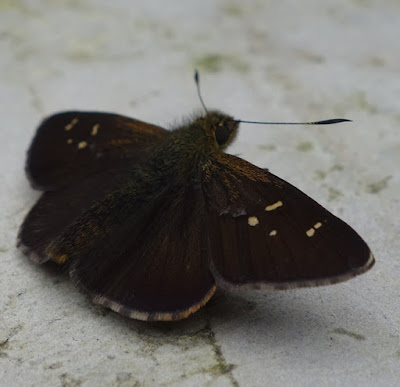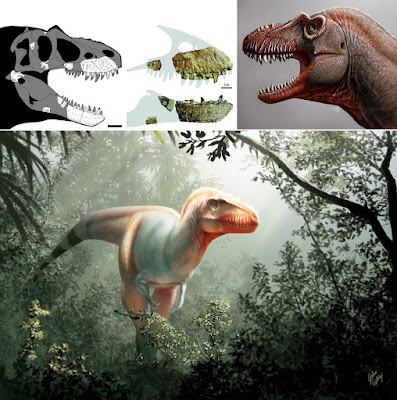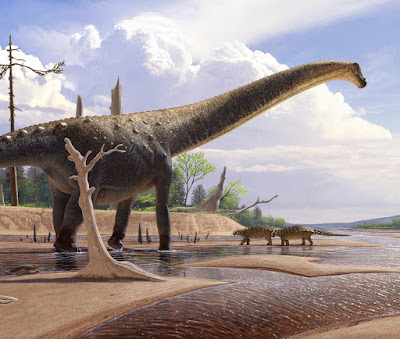[Most Recent Entries] [Calendar View]
Tuesday, February 11th, 2020
| Time | Event | ||
| 4:32a | [Entomology • 2020] Sovia liuzihaoi • A New Species of the Genus Sovia Evans, 1949 (Lepidoptera, Hesperiidae) from South Central Yunnan, China
Abstract A new species of the genus Sovia Evans, 1949, viz. Sovia liuzihaoi Huang & Fan sp. nov. is described from Mt. Ailao, Xinping Yi and Dai Autonomous County, representing a remarkable geographically southward extension of this genus in Yunnan Province, Southwestern China. In general appearance S. liuzihaoi Huang & Fan sp. nov. resembles S. separata magna (Evans, 1932), but in our molecular phylogenetic analyses, this species is clustered with S. lii Xue, 2015. The adults and male genitalia of the new species and related species are illustrated. Keywords: Lepidoptera, Aeromachini, Hesperiinae, taxonomy, molecular phylogeny Sovia liuzihaoi Huang & Fan sp. nov. Si-Yao Huang, Xin-Yue Wang and Xiao-Ling Fan. 2020. A New Species of the Genus Sovia Evans, 1949 from South Central Yunnan, China (Lepidoptera, Hesperiidae) Zootaxa. 4731(4); 565–573. DOI: 10.11646/zootaxa.4731.4.9 | ||
| 10:22a | [Paleontology • 2020] Thanatotheristes degrootorum • A New Tyrannosaurine (Theropoda: Tyrannosauridae) from the Campanian Foremost Formation of Alberta, Canada, provides Insight Into the Evolution and Biogeography of Tyrannosaurids
Highlights • A new genus of tyrannosaurid from the mid Campanian Foremost Formation of southern Alberta is described. • The new genus is found to be the sister taxon to Daspletosaurus spp., and together form the new clade Daspletosaurini. • Tyrannosauridae is revealed to be comprised of multiple, multigeneric clades rather than a series of monogeneric branches. • Geographic segregation of clades provides evidence for provinciality of Tyrannosauridae within North America during the Campanian. Abstract Late Cretaceous tyrannosauroid material from North America was primarily known from upper Campanian through Maastrichtian formations until the recent discovery of derived tyrannosaurid taxa from lower-to-mid Campanian deposits in the southwestern United States. However, diagnostic material from contemporaneous deposits further north in Alberta (Canada) and Montana (USA) has yet to be documented. Here we report the discovery of a new tyrannosaurid from the mid-Campanian Foremost Formation of Alberta, Thanatotheristes degrootorum gen. et sp. nov., which helps fill this gap. Thanatotheristes is found to be the sister taxon to the late Campanian tyrannosaurine genus Daspletosaurus based on several synapomorphies, such as an extremely coarse subcutaneous surface of the maxilla, a constricted jugal ramus of the maxilla, a shallow angle of the anteroventral corner of the maxilla, a high tooth count, a wide prefrontal, and a dentary chin located ventral to either the third alveolus or third interdental plate. Together, these taxa provide evidence for the existence of a clade of long-, deep-snouted tyrannosaurines endemic to northern Laramidia during the Campanian. Our study demonstrates that Tyrannosauridae consists of several geographically segregated clades rather than a series of monogeneric successive sister taxa as recovered by previous studies. The geographic segregation of tyrannosaurid clades within North America provides renewed evidence for provinciality among large theropods during the Late Cretaceous. Keywords: Theropoda, Tyrannosauridae, Campanian, Evolution, Provinciality, Biogeography SYSTEMATIC PALEONTOLOGY Dinosauria Owen, 1842 Theropoda Marsh, 1881 Tetanurae Gauthier, 1986 Coelurosauria von Huene, 1914 Tyrannosauridae Osborn, 1906 Tyrannosaurinae Osborn, 1906 Daspletosaurini clade nov. INCLUDED TAXA: Daspletosaurus torosus Russell, 1970, Daspletosaurus horneri Carr et al., 2017, and Thanatotheristes degrootorum gen. et. sp. nov. Thanatotheristes gen. nov. Thanatotheristes degrootorum gen. et sp. nov. ETYMOLOGY: From Thanatos, the Greek god of and embodiment of death, and theristes (Greek), one who reaps or harvests, a reaper. The specific name, degrootorum, is in honor of John and Sandra De Groot of Hays, Alberta, who discovered the holotype specimen and have been supportive of paleontological research in the area. Jared T. Voris, François Therrien, Darla K. Zelenitsky and Caleb M. Brown. 2020. A New Tyrannosaurine (Theropoda: Tyrannosauridae) from the Campanian Foremost Formation of Alberta, Canada, provides Insight Into the Evolution and Biogeography of Tyrannosaurids. Cretaceous Research. In Press - 104388. DOI: 10.1016/j.cretres.2020.104388 Announcing a New Meat-eating Dinosaur from Alberta RoyalTyrrellMuseum.wpcomstaging.com/2020/02/10/announcing-a-n A Newly Discovered Tyrannosaur Was Key to the Rise of Giant Meat-Eaters | ||
| 2:52p | [Paleontology • 2020] Abdarainurus barsboldi • An Unusual New Sauropod Dinosaur from the Late Cretaceous of Mongolia
Abstract A new sauropod, Abdarainurus barsboldi gen. et sp. nov., is described based on several anterior and one middle caudal vertebrae and chevrons from the Late Cretaceous Alagteeg Formation at Abdrant Nuru, northern Gobi Desert, Mongolia. The new taxon is characterized by 16 unique or rare characters of the caudal skeleton, including opisthocoelous centra, longitudinal ridges on the neural canal walls, postprezygapophyseal processes, a hypertrophied postspinal fossa, mediolaterally constricted neural spines, and a deep pocket-like spinodiapophyseal fossa covered laterally by high postzygodiapophyseal lamina. Our preferred phylogenetic analysis places Abdarainurus as a basal titanosaurian sauropod, but this result could be affected by inadequate knowledge of basal titanosaurs. The new taxon likely represents a highly specialized lineage of Asian macronarian sauropods that was unknown previously. Keywords: Dinosauria, Sauropoda, Titanosauria, Mongolia, Late Cretaceous Systematic palaeontology Sauropoda Marsh, 1878 Titanosauriformes Salgado, Coria & Calvo, 1997 Titanosauria Bonaparte & Coria, 1993 incertae sedis Abdarainurus gen. nov. Etymology. From Abdarain Nuru, the Russian spelling for the Abdrant Nuru locality, and urus, Latinized Ancient Greek ουρά (the tail). Abdarainurus barsboldi sp. nov. Etymology. In honour of Mongolian palaeontologist and academician R. Barsbold. Alexander O. Averianov and Alexey V. Lopatin. 2020. An Unusual New Sauropod Dinosaur from the Late Cretaceous of Mongolia. Journal of Systematic Palaeontology. DOI: 10.1080/14772019.2020.1716402 |
| << Previous Day |
2020/02/11 [Calendar] |
Next Day >> |












